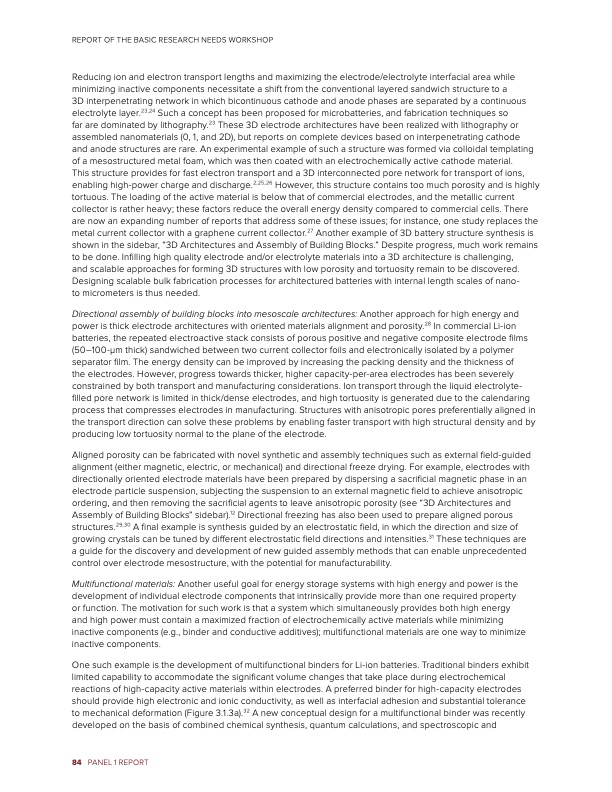
PDF Publication Title:
Text from PDF Page: 090
REPORT OF THE BASIC RESEARCH NEEDS WORKSHOP Reducing ion and electron transport lengths and maximizing the electrode/electrolyte interfacial area while minimizing inactive components necessitate a shift from the conventional layered sandwich structure to a 3D interpenetrating network in which bicontinuous cathode and anode phases are separated by a continuous electrolyte layer.23,24 Such a concept has been proposed for microbatteries, and fabrication techniques so far are dominated by lithography.23 These 3D electrode architectures have been realized with lithography or assembled nanomaterials (0, 1, and 2D), but reports on complete devices based on interpenetrating cathode and anode structures are rare. An experimental example of such a structure was formed via colloidal templating of a mesostructured metal foam, which was then coated with an electrochemically active cathode material. This structure provides for fast electron transport and a 3D interconnected pore network for transport of ions, enabling high-power charge and discharge.2,25,26 However, this structure contains too much porosity and is highly tortuous. The loading of the active material is below that of commercial electrodes, and the metallic current collector is rather heavy; these factors reduce the overall energy density compared to commercial cells. There are now an expanding number of reports that address some of these issues; for instance, one study replaces the metal current collector with a graphene current collector.27 Another example of 3D battery structure synthesis is shown in the sidebar, “3D Architectures and Assembly of Building Blocks.” Despite progress, much work remains to be done. Infilling high quality electrode and/or electrolyte materials into a 3D architecture is challenging, and scalable approaches for forming 3D structures with low porosity and tortuosity remain to be discovered. Designing scalable bulk fabrication processes for architectured batteries with internal length scales of nano- to micrometers is thus needed. Directional assembly of building blocks into mesoscale architectures: Another approach for high energy and power is thick electrode architectures with oriented materials alignment and porosity.28 In commercial Li-ion batteries, the repeated electroactive stack consists of porous positive and negative composite electrode films (50–100-μm thick) sandwiched between two current collector foils and electronically isolated by a polymer separator film. The energy density can be improved by increasing the packing density and the thickness of the electrodes. However, progress towards thicker, higher capacity-per-area electrodes has been severely constrained by both transport and manufacturing considerations. Ion transport through the liquid electrolyte- filled pore network is limited in thick/dense electrodes, and high tortuosity is generated due to the calendaring process that compresses electrodes in manufacturing. Structures with anisotropic pores preferentially aligned in the transport direction can solve these problems by enabling faster transport with high structural density and by producing low tortuosity normal to the plane of the electrode. Aligned porosity can be fabricated with novel synthetic and assembly techniques such as external field-guided alignment (either magnetic, electric, or mechanical) and directional freeze drying. For example, electrodes with directionally oriented electrode materials have been prepared by dispersing a sacrificial magnetic phase in an electrode particle suspension, subjecting the suspension to an external magnetic field to achieve anisotropic ordering, and then removing the sacrificial agents to leave anisotropic porosity (see “3D Architectures and Assembly of Building Blocks” sidebar).12 Directional freezing has also been used to prepare aligned porous structures.29,30 A final example is synthesis guided by an electrostatic field, in which the direction and size of growing crystals can be tuned by different electrostatic field directions and intensities.31 These techniques are a guide for the discovery and development of new guided assembly methods that can enable unprecedented control over electrode mesostructure, with the potential for manufacturability. Multifunctional materials: Another useful goal for energy storage systems with high energy and power is the development of individual electrode components that intrinsically provide more than one required property or function. The motivation for such work is that a system which simultaneously provides both high energy and high power must contain a maximized fraction of electrochemically active materials while minimizing inactive components (e.g., binder and conductive additives); multifunctional materials are one way to minimize inactive components. One such example is the development of multifunctional binders for Li-ion batteries. Traditional binders exhibit limited capability to accommodate the significant volume changes that take place during electrochemical reactions of high-capacity active materials within electrodes. A preferred binder for high-capacity electrodes should provide high electronic and ionic conductivity, as well as interfacial adhesion and substantial tolerance to mechanical deformation (Figure 3.1.3a).32 A new conceptual design for a multifunctional binder was recently developed on the basis of combined chemical synthesis, quantum calculations, and spectroscopic and 84 PANEL 1 REPORTPDF Image | Next Generation Electrical Energy Storage

PDF Search Title:
Next Generation Electrical Energy StorageOriginal File Name Searched:
BRN-NGEES_rpt-low-res.pdfDIY PDF Search: Google It | Yahoo | Bing
Sulfur Deposition on Carbon Nanofibers using Supercritical CO2 Sulfur Deposition on Carbon Nanofibers using Supercritical CO2. Gamma sulfur also known as mother of pearl sulfur and nacreous sulfur... More Info
CO2 Organic Rankine Cycle Experimenter Platform The supercritical CO2 phase change system is both a heat pump and organic rankine cycle which can be used for those purposes and as a supercritical extractor for advanced subcritical and supercritical extraction technology. Uses include producing nanoparticles, precious metal CO2 extraction, lithium battery recycling, and other applications... More Info
| CONTACT TEL: 608-238-6001 Email: greg@infinityturbine.com | RSS | AMP |